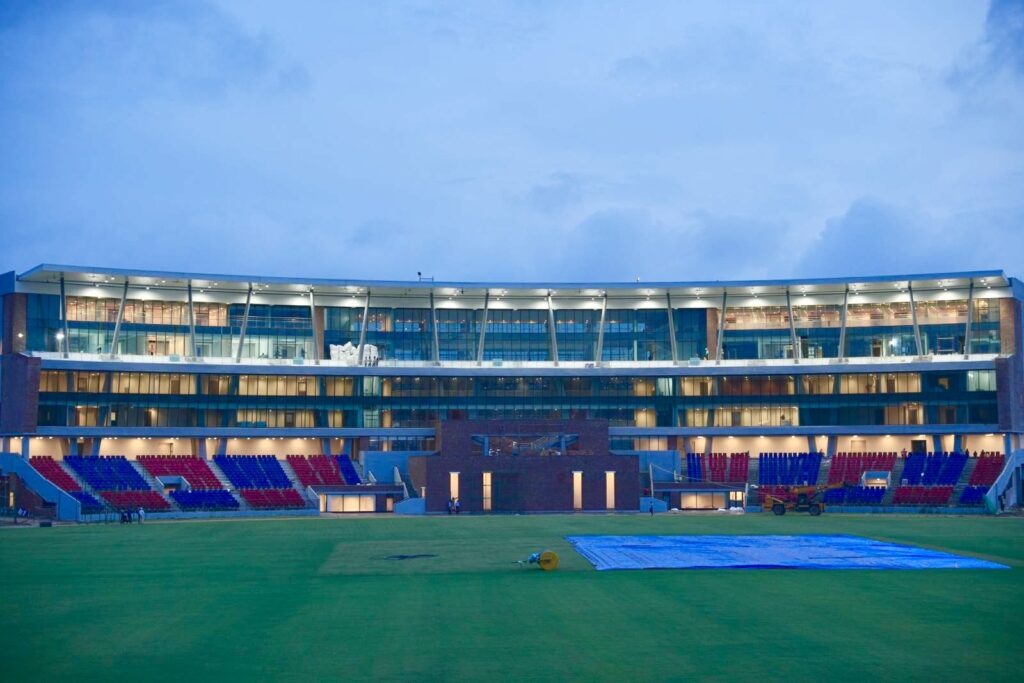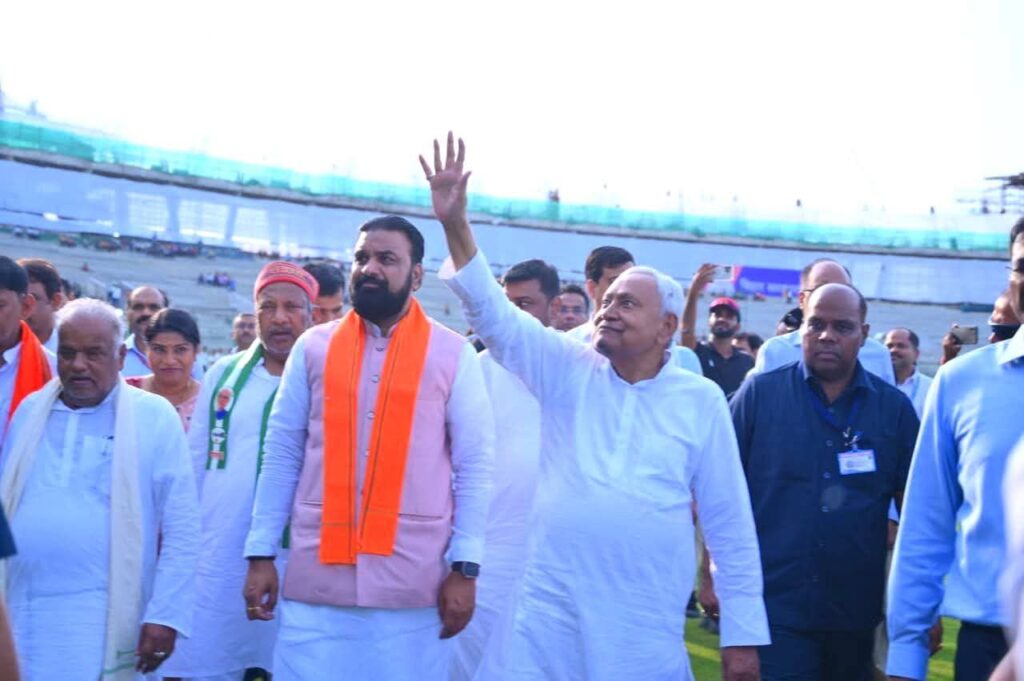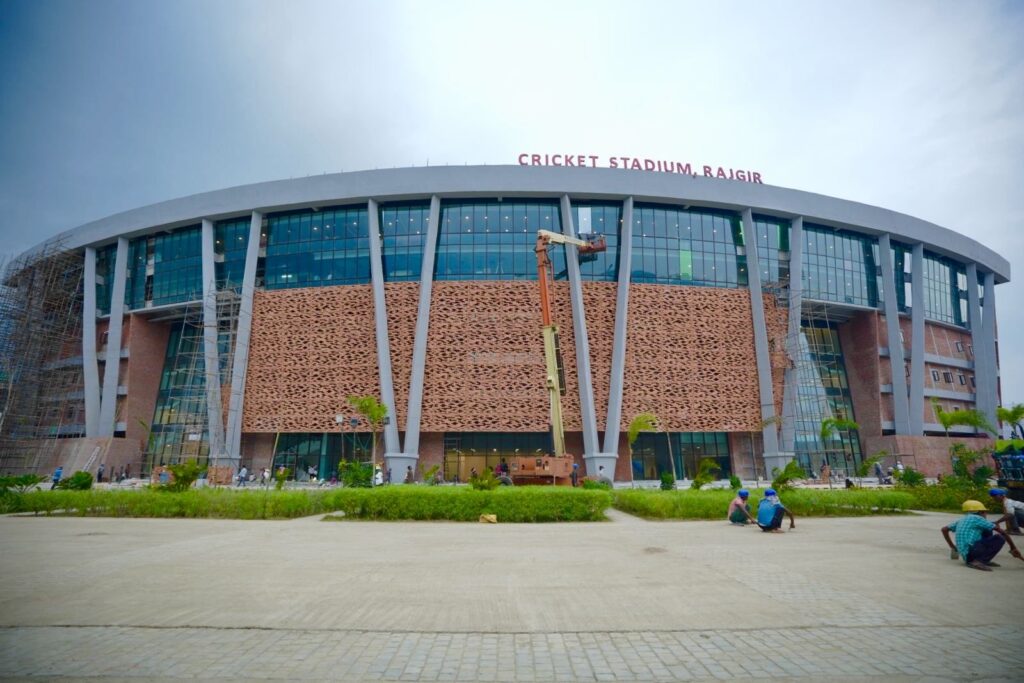Rajgir, Nalanda district, Bihar — October 5, 2025
In a landmark event for Bihar’s sports landscape, Chief Minister Nitish Kumar inaugurated the newly constructed Rajgir International Cricket Stadium today. The state government says the stadium is designed to host international cricket matches, and can accommodate about 40,000 spectators.
The occasion was attended by officials, athletes, local dignitaries, and sports lovers, marking what many hope will be a turning point in Bihar’s long-standing quest to reclaim a place on India’s cricketing map.
Background and Rationale
Bihar, once home to the Moin-ul-Haq Stadium in Patna, had seen declining fortunes in terms of hosting major international cricket matches. Moin-ul-Haq Stadium, with a capacity around 25,000, had hosted only a few One Day Internationals (ODIs) in the 1990s and has, over the years, fallen into relative disuse for high-profile cricket events.
Recognizing the need for modern infrastructure, the Bihar government envisaged a world-class stadium in Rajgir, within a larger sports complex, to provide better facilities, nurture local talent, and bring Bihar back into the fold of states able to host international-level matches.
In August 2024, Nitish Kumar had inaugurated the Rajgir Sports Complex and Bihar Sports University, underlining the administration’s intent to build a sporting ecosystem in the region.
The Rajgir stadium project had long gestation: the foundation stone was laid in 2018, with an initial estimate and design modeled after the Sydney Cricket Ground. Plans called for modern facilities, drainage systems, media zones, VIP stands, and higher standards consistent with BCCI/ICC expectations.
Key Features and Facilities
According to government and media sources, the stadium and complex boast several notable features:
- The stadium is spread over approximately 18 acres of land.
- Seating capacity is reported to be in the range of 40,000 spectators (some sources also mention 45,000, likely reflecting design flexibility)
- A five-storey (G + 5) pavilion has been constructed, featuring lounges for players, reserved seating for coaches and managers, VIP stands, and a dedicated media gallery.
- The playing surface accommodates six red-soil pitches sourced from Maharashtra and seven black-soil pitches from Mokama.
- A modern drainage system has been installed to manage seasonal rains and protect the pitch from waterlogging.
- Other amenities include basic facilities for players and spectators, VIP and VVIP areas, media facilities, and provisions for match-day operations.
- The stadium reportedly meets or is built in line with BCCI and ICC standards, making it capable of hosting national and international matches.
- In terms of cost and scale, some reports place the construction expense at over ₹1,100 crore (some variation exists among sources) and suggest that the complex covers more than just the stadium itself.
The Inauguration Event
The formal inauguration took place on October 5, 2025, at Rajgir. During the ceremony, Chief Minister Nitish Kumar toured the pavilion, inspected the playing surface, and reviewed the various facilities.
He declared that the stadium is “fully equipped to host international cricket matches in the near future,” and expressed confidence that Bihar would begin to host global-level cricket events after years of absence.
In conjunction with the inauguration, the state government also used the platform to announce welfare measures and recognitions for sportspersons. Under the “Medal Lao, Naukri Pao” (Bring Medals, Get Jobs) scheme, 87 sportspersons (39 women and 48 men) were issued appointment letters for various government positions.
Additionally, ₹8 crore in sports honorariums were distributed among 812 athletes for their achievements in national and international competitions. Symbolic cheques were also given to select players: Shailesh Kumar (₹75 lakh), Bobby Kumar (₹35 lakh) and Goldy Kumari (₹10 lakh) as part of the awards initiative.
The event also reinforced the government’s broader commitment to promoting sports culture, youth development, and infrastructure across Bihar.
Why This Matters: Implications and Challenges
Restoring Bihar’s Place in Cricket
For decades, Bihar had lagged behind many states in terms of cricket infrastructure and visibility. With the decline of the Moin-ul-Haq Stadium and limited opportunities for hosting national or international matches, local athletes often had to seek facilities elsewhere. The Rajgir stadium aims to reverse that trend and give Bihar a competitive edge in sports development.
Boost to Talent Pipeline and Local Ecosystem
By having high-quality infrastructure locally, budding cricketers from Bihar can train, compete, and gain exposure without migrating to other states. This may help retain talent, encourage grassroots participation, and strengthen the link between local academies and elite sport.
The integrated nature of the Rajgir sports complex, combined with the recently inaugurated Bihar Sports University, may create synergies across multiple disciplines and nurture a culture of athleticism in the state.
Economic, Tourism, and Urban Spillovers
Rajgir, already a well-known tourist destination (given its historical and cultural significance), stands to gain from increased footfall if international cricket is hosted here. The stadium could spur demand for lodging, transport, services, and ancillary businesses.
In addition, by locating world-class infrastructure in a semi-urban area, the government may help distribute economic development beyond major cities.
Operational, Logistical & Institutional Hurdles
However, the ambitious project also faces a few challenges:
Scheduling & Match Allocation: Even with a capable stadium, attracting international or top-tier domestic matches depends on BCCI scheduling, cricketing calendar slots, and competition with more established stadiums.
Management and Maintenance: The Bihar government’s plan includes transferring management rights of the Rajgir stadium to the Bihar Cricket Association (BCA), which is affiliated with BCCI. This shift is intended to streamline operations and align with cricket governance structure.
Connectivity & Infrastructure Support: Effective transport, accommodation, utilities, and supporting infrastructure will need to be robust, especially during big events. While proposals are underway to improve road connectivity (e.g., Buddhist Circuit road between Patna and Rajgir) , ensuring last-mile and event-centric amenities will be critical.
Sustainability & Ongoing Financial Viability: Running a stadium is capital intensive; generating revenue from ticketing, concessions, events, and multi-use functions will be essential to justify maintenance costs.
Expectation Management: While media reports place seating capacity at 40,000, some sources suggest up to 45,000, and earlier plans had wider land area footprints. Delivering consistently to international standards over time will demand constant upkeep and upgrades.
Looking Ahead
With the inauguration now complete, Bihar’s government and sports bodies will need to act on several fronts:
1. Securing Cricket Fixtures
The authorities will need to negotiate with BCCI and international boards to anchor domestic and international matches at Rajgir, ensuring use of the facility and visibility for Bihar cricket.
2. Operationalizing Management
Handing over or delegating management to the BCA is a critical step. If done effectively, it can leverage cricket governance structures, revenue models, and scheduling networks.
3. Supporting Infrastructure Upgrades
Improvement of road access, transport links, parking, power and utilities, hospitality (hotels, guest houses), and last-mile services will enhance the spectator and athlete experience.
4. Marketing & Positioning
To attract marquee events, the stadium must build a reputation for quality, reliability, and spectator experience. Strategic marketing, sports tourism partnerships, and media promotion will help.
5. Monitoring and Continuous Improvement
Ongoing maintenance, feedback loops (from teams, broadcasters, fans), and upgrading equipment (e.g. floodlights, pitch technology) will be necessary to keep the venue match-ready.
If successful, Rajgir could become a model for how states outside traditional cricket strongholds can invest in and leverage sports infrastructure for talent, prestige, and growth.
The inauguration of the Rajgir International Cricket Stadium marks a bold and historic step in Bihar’s sports journey. By providing state-of-the-art infrastructure, the state government has signaled its commitment to repositioning Bihar within India’s cricketing and sporting map. Whether the stadium can deliver on its promise will depend on the follow-through — securing matches, managing operations efficiently, and integrating it into larger sporting and economic ecosystems. But at least now, Rajgir is ready to host cricketing dreams.
Related News: Read More





